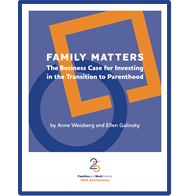
The World Economic Forum in Davos just ended, and with it came news that the gender gap in still alive and well, especially in the United States, which is ranked behind Nicaragua, Burundi and Latvia, just to name a few.
Now in its ninth year, the Gender Gap Index, put out by the Forum, shows progress on many fronts but it also shows that the gap in terms of women's advancement into leadership in both the private and public sector persists.
One reason for the gap at the top is that mothers who've chosen to dial back at work -- even for relatively short periods of time -- have often been sidetracked and sometimes derailed from the leadership track. But, now that more men are doing more of the caregiving and feeling the career pain for it, as our research shows, who is going to be left to lead?
In most organizations, the path to leadership is based on the assumption that each person has roughly 40 years of uninterrupted time to devote to work, and that those years will unfold in lock-step fashion, meaning that in your 20s and early 30s you get established, in your mid-30s and 40s, you gun for the top, and in your 50s and early 60s, you lead from the top. Then you retire. This is the corporate ladder in a nutshell. The controversy over frozen embryo coverage is the most recent evidence that this ladder thinking is still alive and well.
Which is why it's no surprise that women in their 30s and 40s are the group most likely to say that "it is not possible for most people to succeed at work and have enough time to contribute to their family, and their community," according to the 2014 Heartland Monitor Poll released last year.
Even great maternity leave benefits and flexible work options do not necessarily result in higher levels of women in senior leadership, as the research in both the U.S. and Europe has shown. To be fair, these strategies were actually never designed to advance women, only to retain them, and they work in that respect, as we show in Family Matters: The Business Case for Investing in the Transition to Parenthood. But these practices do little to address the path to leadership.

In a study of 25,000 Harvard Business School graduates designed to understand why the gender gap in leadership is so persistent, the one factor that stood out was mismatched expectations between men and women about who was going to be responsible for the home front. Even among Millennials, men were much more likely to say that they expected to be in a traditional relationship, where their career was primary. Women end up making their career secondary, even if it is not what they intended.
The struggle to make sense of shifting gender roles both at home and at work is real, and each one of us has to figure out what we want for ourselves on both fronts. But it cannot be up to each of us alone to figure this out, because there is too much at stake for us all.
The quality of leadership around the world hangs in the balance, because the system is rigged against working mothers and fathers, and really any working caregiver, who prioritizes family life over work -- especially at critical points in the traditional career trajectory. As the emerging research on paternity leave makes clear, corporate ladder thinking penalizes anyone -- male or female -- who isn't gunning for it during those, middle childbearing years.
They just aren't seen as leadership material. But it doesn't have to be that way.
Take Bob Moritz, the current U.S. Chairman of PwC. He has talked openly about the time in the middle of his career when he went through marriage counseling, a divorce, and the day-to-day challenges of being a single dad to two young children. At one point, he turned down a promotion -- a move that felt risky from a traditional career standpoint.
While Moritz got back on track, many people in his position don't. To change this outcome, and therefore change the leadership pipeline, requires two shifts, from an organizational perspective:
- rethinking how careers are built, and
But even redesigning career paths is not enough. We also need to reframe how we assess leadership potential -- in two key ways. First, we have to stop assuming that a desire to dial-down at one point in time reflects a lack of interest in dialing up later on.
Equally as important, organizations have to learn how to judge potential for leadership based on more than whether a person has consistently been focused exclusively on his or her career.
Leaders don't get to be leaders overnight. They get there because those already in leadership have judged, either formally or informally, their track record and potential of those in the leadership pipeline. In all too many organizations, women (and, research is now showing, men) who dial down their careers at one point in time are often forever marked as lacking leadership potential.
Current leaders have a responsibility to think differently about leadership potential. Under Moritz's leadership, for example, PwC is making systemic changes so that those who dial down in the middle are not marked forever by those choices. The firm doesn't judge the annual performance of someone who takes four months parental leave using the same metrics as someone who worked the whole year. The firm also allows professionals to off ramp completely for a period of time. One woman who did came back to the firm and just made partner.
Our research shows that you don't always have to put work first in order to rise to the top. In a large study of global leaders, roughly one-third of very senior executives were what we labeled "dual centric" -- they sometimes prioritized personal life over work and sometimes prioritized work over personal life. They were not only just as successful at work as executives who consistently put work first, but they felt much more successful at home.
Lisa Blatt, a partner at global law firm Arnold & Porter, is a case in point. She has argued more cases in the Supreme Court than any other woman lawyer, and has won 29 out of 30. She runs a big practice at a major firm. She also works part-time, and she even took a six month sabbatical in the middle of her career, when her kids were young, to decide whether she wanted to be a full-time, stay-at-home mom. But Lisa is still the exception, not the rule.
It is time to turn the tables and put in place organizational systems and talent processes that reward the kinds of choices and behaviors that dual centric executives embody. To help understand what this will take, the Families and Work Institute is embarking on a new study of leadership in the global economy.
Let's hope that next year at Davos, the conversation at Davos will be about how all leaders, not just women, can prioritize both their work and their families to achieve outstanding results.